
| Home | Table of contents | Keys | Species list | Glossary | Image data | PDF | Cite this article | Feedback | Updates |
Identification Atlas of the Vespidae (Hymenoptera, Aculeata) of the northeastern Nearctic region
CJAI 05, February 19, 2008
doi: 10.3752/cjai.2008.05
Matthias Buck, Stephen A. Marshall, and David K.B. Cheung
Department of Environmental Biology, University of Guelph, Guelph, Ontario, Canada N1G 2W1
Next species | Previous species | Key
98. Vespula vulgaris (Linnaeus, 1758)
Figs B13.2, 13, 15, 40–43, 62, 73; C98.1–14.
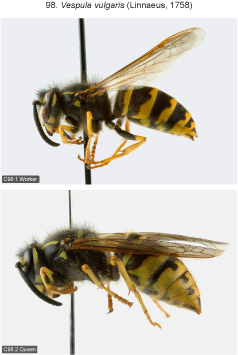 |
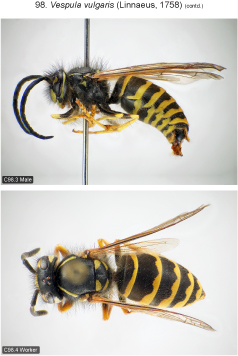 |
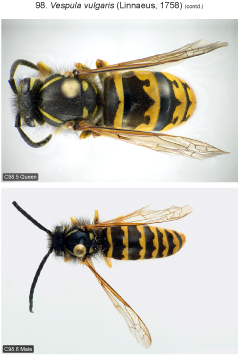 |
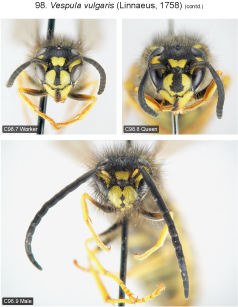 |
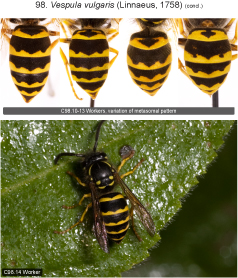 |
Species recognition. This species can be diagnosed by the relatively broad black band (width at least 2x mid ocellar diameter) between the corona and the ocular sinus. Species of the V. rufa-group are similar in this regard but possess a pair of well-defined, enclosed, yellow spots within the black basal band of tergum 1, these spots are well separated from the yellow apical fascia. Exceptionally, enclosed yellow spots are developed in V. vulgaris, but in this case they are of irregular shape and only narrowly separated from the apical fascia.
Variation. Fore wing length 8.0–10.5 mm (workers), 12.5–14.0 mm (♀♀), 11.5–13.5 mm (♂♂). Clypeus of female usually with black central mark extending to dorsal margin and widened ventrally (rarely with two spots separate from mark), the mark in worker frequently, in queen sometimes also connected to ventral margin; male clypeus with an elongate vertical mark that is usually interrupted one or more times, in extreme cases forming complete stripe that reaches both dorsal and ventral margins, or mark reduced to two spots. Black subantennal mark sometimes with enclosed yellow spots (rarely deep dorsal emarginations) in females; spots or deep dorsal emarginations almost always present in male. Yellow postocular band interrupted, abruptly narrowed or with enclosed black spot near middle, continuous in male. Scape black, in male with yellow anterior mark. Pronotal lobes and propodeum of worker exceptionally with small yellow spots (1 spm., ON, Manitouwadge, DEBU). Yellow spots of metanotum small in male, rarely absent. Black basomedial mark of tergum 1 very variable in worker: most commonly basal band produced backward in from of a wide triangle medially, very rarely with enclosed irregular yellow spots near summit; sometimes with anchor- or arrow-shaped medial mark, the minimum width of mark twice its length; minimum width of basal attachment 2x mid ocellar diameter. Xanthic workers rarely with evanescent enclosed yellow spots on tergum 2. Free black discal spots rarely present on tergum 2 (worker) or terga 3–5 (queen).
Distribution. Canada: every province and territory except NU. Northern and western U.S.: AK, south to GA, KY, IL, IA, NE, NM, AZ and CA. Mexico: Durango, México, Michoacán and Oaxaca. Palaearctic (and adjacent parts of Oriental): Europe to Sakhalin, Japan, northern China, south to Turkey, Iran, northern India. Introduced to Hawaii, Iceland, New Zealand and Australia (Victoria, Tasmania) (Rodríguez-Palafox 1996, Carpenter and Kojima 1997).
Biology. Nests are usually subterranean but are sometimes also built in rotten logs or stumps, forest duff, hollow walls or even aerial locations. Females prey on a wide variety of arthropods in addition to scavenging on carrion. Vespula vulgaris is one of the major pest yellowjackets in the west but in the east it presents a much lesser problem than V. maculifrons and V. germanica (Akre et al. 1981).
Next species | Previous species | Key
| Home | Table of contents | Keys | Species list | Glossary | Image data | PDF | Cite this article | Feedback | Updates |
